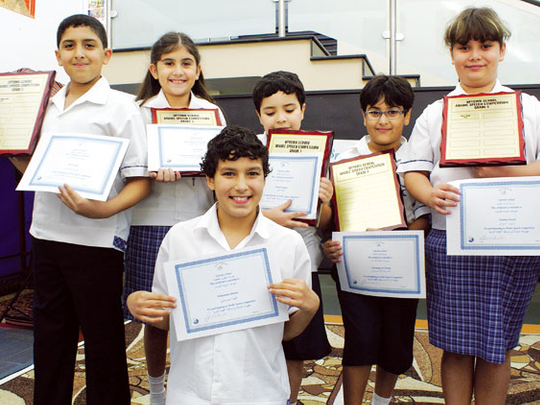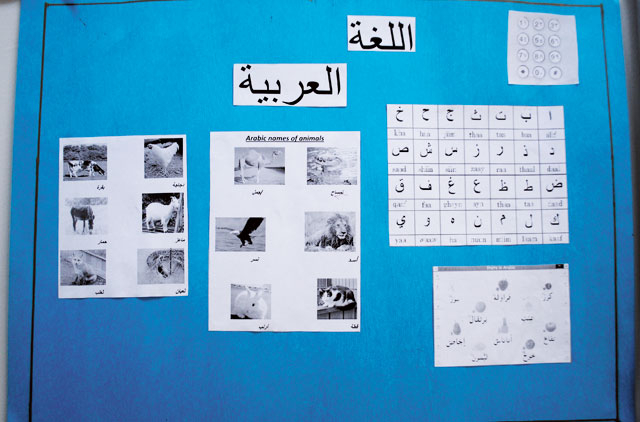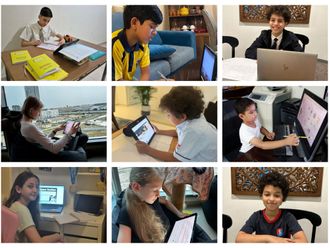
Under a ghaf tree in a school in Jordan, a group of children is being introduced to the word warda.Warda means a flower in Arabic. The instructor is wearing a floral dress and holding a rose in her hand. She puts the rose down, picks up a sunflower and repeats the word and the children repeat in chorus ‘Warda'. Then they switch to English and say the word ‘flower' and follow it up again with the Arabic word warda. In the poetry class after this, the same group of children sings a melodious rhyme about a warda. Following the poetry class is an art and crafts session. The children first draw a bunch of flowers, colour them, cut them out and paste them in their art books. By the end of the day, these children have experienced a flower by sight, smell, sound and touch. The word warda and its English translation, ‘flower', are now firmly embedded in their formative minds.
This is a new method of making learning Arabic more fun and interactive, using an approach that veers away from the traditional methods of teaching, says Dr Samia Al Farra, chief education officer of Taaleem, and the woman behind this project. Taaleem is a Dubai-based company that seeks to provide high quality primary and secondary education. An integrated multisensory way of learning vocabulary in Arabic, this strategy is being adopted in many schools across the Middle East, including the UAE, to enable both native and non-native speakers to learn the language, especially when it is taught in their formative years.
Arabic: beautiful but complex
Learning a language can be rigid due to the structure or it can be free flowing and creative - somewhere between these extremes lies a method that could make this extremely complex human ability a highly effective one, and produce extraordinarily successful results. Noam Chomsky, the famous socio-political writer and professor of linguistics at the Massachusetts Institute of Technology (MIT), says a language is unique to the culture that created it. It reflects the values and concepts considered to be the most important by that culture. Based on that view, learning a language becomes as important as teaching it. In fact, the two historically prevalent methods of teaching a language are the oral tradition and the academic one. These methods have proven over time that a lesson is only as effectively learnt as it is taught. In this simplicity, lie the seeds of success.
Multisensory approach
The teaching, and learning of Arabic, a beautiful but complex language, is being routed through this new multisensory methodology for many reasons. So far, most expatriates in the UAE have managed their lives without so much as a working knowledge of the Arabic language. Making it easier to learn will attract more people to learn it well, whether they are UAE nationals or expatriates.
The need to integrate the language into the consciousness of second-generation expatriate students studying in schools has always held its importance and now it has gained an interesting dimension with this initiative launched by Taaleem, which means education in Arabic. It has been formed with the vision to raise the standards of education significantly in the region and inspire young minds. The establishment opens its first International Baccalaureate school on Al Wasl Road in Jumeirah this September. Called Jumeirah Baccalaureate, the school will have the best international IB standards and as an added feature, it will adopt an interesting curriculum to teach Arabic as well, from kindergarten onwards.
Dr Samia is the face of IB education in the Middle East and a co-founding member of the Middle East International Baccalaureate Association. She is also a member of the IB Europe, Africa and Middle East Regional Council and former member of the IB council foundation. A prominent educator with over 37 years of experience in education, she has held important offices in the Jordanian Ministry of Education and her most striking strength is that she has successfully run the bilingual English and Arabic curriculum for 18 years at the Amman Baccalaureate School where she has been the principal since 1991.
Dr Samia strongly feels that if society wants to see a healthy integration of the Arabic language into the everyday life of students, it is important not to impose it as a stern discipline but to introduce it non-intrusively into their lives. "When children learn to speak Arabic well and use it functionally by putting it into practice, the language will not die. That is why in the early learning years in Amman we use [a percentage approach] to learning. The child learns Arabic from KG to Grade 6 with 40 per cent of class time being in Arabic and 60 per cent in English.
"From Grade 6 onwards, we adopt the 80-20 approach, where 80 per cent is in English and 20 per cent continues to be taught in the Arabic language. In Dubai, we are at the moment content using the 15-85 approach, where 15 per cent is in Arabic and the rest of the instruction is in English."
Tapping the talent of children
"Language is culture and to be bilingual means to be bicultural. By not teaching our children to love their mother tongue the same way they love English, we are creating third culture children who could be less interested in their primary cultural identity. For a country to survive the modern challenge of international living and globalisation, bilingualism is important in building bridges between the two worlds."
Dr Samia is very enthusiastic about the new approach Taaleem will be adopting to teach Arabic. The strategy stems from the versatility, grasping power and unbridled enthusiasm of young minds that are like enormous sponges waiting to absorb anything life offers them.
"Kids by nature are artists," she says. "Once we master the art of tapping that potential, we are able to connect with them. To act as the impetus to that enthusiasm we want our teachers to be happy, funny, engaging and fun to learn with. A child's innate ability and curiosity to learn more coupled with teachers who impart education in a way that engages that curiosity is bound to make a child fall in love with what is being taught; in this case, the Arabic language."
Learning by heart
"We believe in authentic methods of assessment and want the children to learn the functional use of the language rather than just learning a lesson by rote," says Dr Samia.
The (IB) school plans to introduce Arabic language from kindergarten in a non-intrusive way. "We plan to take 100 common words in Arabic such as the different organs of the body, the names to address parents, the days of the week, numbers, etc., and introduce it into the child's life with the intention of gradually building up the child's vocabulary in the language. When the same words are used in different settings and they are repeated throughout KG 1 and KG 2, the child will understand them better and will use them to form a sentence.
"We are going to use a multisensory approach and many other teaching aids to instil a concept in three or four ways into the child's mind. For instance, Markeb in Arabic means a boat. First the child will see the boat on the visual cards, then in a craft class he will make a paper boat and cut out a boat from a picture. He/she will then float his boat. In an art class, he/she will create one out of clay and in a music class he will sing about it, and in the language class he will write a sentence using it.
This concept will be further fleshed out in the relative values of being ‘heavy' and ‘light'. For example, yatfu means to float and yaghoos means to sink. He/she will be able to immediately connect this idea to the concept of markeb. This integrated approach will enable the multidimensional concept of the word to be imprinted on a child's mind."
Focusing on the finer details of the methodology, children are going to be encouraged to write their own stories, even if it means drawing a picture with only a few lines describing the visual. These will be electronically printed. The aim is to encourage the child to write and paint and give him a unique sense of pride.
When he/she paints and puts his name to a book, he will have the creative satisfaction of being an author and each child can then share his book with other students in the class. Together the children will be able to share the stories they create.
The teacher must be the subject of her lesson
To begin with, Dr Samia believes that a teacher must be the subject she teaches. For instance, an art teacher must be an artist and have a passion for teaching. The same analogy would extend to drama, fine arts, performing arts and so on. Another aspect essential to teaching is the invaluable ability to listen to a child. "For the last 100 years, teaching has meant instructing. We are not looking closely at the end result of the teaching - the learning - that can come about only when we listen to the student," she says. Dr Samia believes it is important for a subject like Arabic to be taught not just from the book.
"So far the conventional method has been teaching Arabic language from the book prescribed for that class. But the way we see it is the book forms just 1/9th of the curriculum. In our curriculum, we include activities, assignments and other aspects of interactive education where the student totally imbibes the language and it is open for the inspectors to check our curriculum." Her model of the curriculum includes:
- The book which is the text prescribed by the Ministry of Education
- Teaching manners or skills a teacher brings to the classroom along with the approach he adopts to translate the book into a live, interactive experience
- Class interaction
- Goals
- Setting up of objectives
- The philosophy of teaching Arabic
- The content which would touch upon far more aspects than just what is in the book
- Skill development that will include conversation, writing, reading, listening and viewing
- Assessments which will not just be limited to an exam but would include class quizzes, a speech, a project, a portfolio, a drama report or a criticism of a news article.
More targets
Beyond this breakaway method are more goalposts that have been put in place to make the method a complete success.
"In the IB school we are highlighting four learning aids," says Dr Samia:
- Children will be encouraged to pursue their spirit of enquiry through the use of art. This would include fine art such as drawing, clay work, etc; performing arts such as drama, poetry recitation and music. There will be considerable emphasis on painting and art.
- Children will be encouraged to have a better understanding of nature and interact with the flora and fauna around them. "We plan to have classes under the trees. If a teacher is talking about the colour green, the child needs to see how many shades of green exist in nature to be able to understand the concept of that colour."
- The school will nurture creativity by allowing the students to embark on their journey of self-discovery through the awareness of shapes, use of textures and articulating their expressions to create their unique projects.
- Community service: If the child is being taught Islamic and social studies, it will be aided by interacting with society. For instance, if the lesson is on respecting elders, the child will learn more about that by interacting with his neighbours, relatives, friends, parents and other members of society.
- "We must make the child aware of the diversity that exists in this multicultural society," says Dr Farra. "They also plan to include the introduction of CDs and DVDs in Islamic studies and simple songs about family values that will make learning about this fun. Grandparents will be invited to speak to children." The child will be tested on his knowledge and understanding through a series of methods that are recognised as authentic assessment aids. These are:
- Quizzes
- Tests
- Projects
- Portfolios
- Presentations
- Reports
- Memos
- Logs
- Discussions
- Writing
- Stories
Suchitra Bajpai Chaudhary is Senior Feature Writer, Friday














